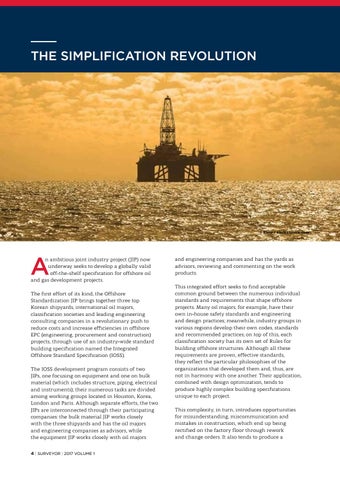THE SIMPLIFICATION REVOLUTION
Š Elnur / Shutterstock.com
A
n ambitious joint industry project (JIP) now underway seeks to develop a globally valid off-the-shelf specification for offshore oil and gas development projects. The first effort of its kind, the Offshore Standardization JIP brings together three top Korean shipyards, international oil majors, classification societies and leading engineering consulting companies in a revolutionary push to reduce costs and increase efficiencies in offshore EPC (engineering, procurement and construction) projects, through use of an industry-wide standard building specification named the Integrated Offshore Standard Specification (IOSS). The IOSS development program consists of two JIPs, one focusing on equipment and one on bulk material (which includes structure, piping, electrical and instruments); their numerous tasks are divided among working groups located in Houston, Korea, London and Paris. Although separate efforts, the two JIPs are interconnected through their participating companies: the bulk material JIP works closely with the three shipyards and has the oil majors and engineering companies as advisors, while the equipment JIP works closely with oil majors
4 | SURVEYOR | 2017 VOLUME 1
and engineering companies and has the yards as advisors, reviewing and commenting on the work products. This integrated effort seeks to find acceptable common ground between the numerous individual standards and requirements that shape offshore projects. Many oil majors, for example, have their own in-house safety standards and engineering and design practices; meanwhile, industry groups in various regions develop their own codes, standards and recommended practices; on top of this, each classification society has its own set of Rules for building offshore structures. Although all these requirements are proven, effective standards, they reflect the particular philosophies of the organizations that developed them and, thus, are not in harmony with one another. Their application, combined with design optimization, tends to produce highly complex building specifications unique to each project. This complexity, in turn, introduces opportunities for misunderstanding, miscommunication and mistakes in construction, which end up being rectified on the factory floor through rework and change orders. It also tends to produce a
